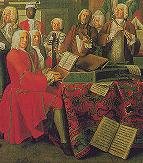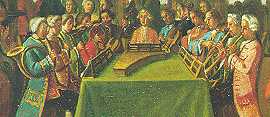Basso Continuo
 PODCAST
PODCAST
A method of thickening musical textures by augmenting the bass line.

|
|
Fig 1: Trio sonata: (L to R) harpsichord, gamba,
violin, flute. P.J.Horemans |
Basso Continuo is a method of thickening musical textures by augmenting the bass line. It is sometimes called "figured bass," "thoroughbass," or simply "continuo." The use of the basso continuo is confined, for the most part, to music of the Baroque era. So widespread was the use of the basso continuo that some people used to refer to the Baroque period as the "basso continuo era." Continuo groups are employed in vocal and instrumental ensembles ranging from three musicians to larger groups. Here are some examples. Listen to the cello and harpsichord that accompany the violin in this sonata by Arcangelo Corelli:
|
|
|
Fig 2: Chitarrone (1), mandolin (2) |
[Example 2: Corelli, Violin Sonata No 1 in D, op. 5., third mvt.]
In this excerpt, drawn from the opera Orfeo by Claudio Monteverdi, a recitative sung by a soprano is accompanied by an elaborate continuo that consists of a small organ, a bass viol, and two plucked instruments, namely a mandolin and a form of large bass lute called a chitarrone:
[Example 3: Monteverdi: Orfeo: Prologue]

|
|
Fig 3: Detail of Figure 1 |
The performance of a continuo part is called its "realization." It requires at least two individuals: a musician who constructs a series of chords using the notes of the bass line with a chord-producing instrument, such as a harpsichord, organ, or lute, and another performer who plays the bass line either at pitch or an octave below. This musician generally performs on a cello or bass, but a viola da gamba, bassoon, or other bass melody instrument could also be used. Here is an example of how a basso continuo functions. The opening ritornello of the Fifth Brandenburg Concerto by J.S. Bach is written for six parts and basso continuo. The continuo, in this case a harpsichord and a violone, which is the largest member of the viol family, performs the bottom line, which is highlighted in this example. (The numbers and symbols above the bass line indicate the types of chords to be played by the keyboardist.):
[Example 4: Fifth Brandenburg Concerto: opening ritornello ]

|
|
Fig 4: Score of opening ritornello from Fifth
Brandenburg Concerto with a highlighted bass line |
Here is what the basso continuo from this excerpt sounds like in isolation. Let's listen first to a performance of the bass line:
[Example 5: opening ritornello: bass line only.]
The addition of the harpsichord completes the continuo:
[Example 6: opening ritornello: bass line and harpsichord.]
|
|
|
Fig 5: Baroque orchestra. Venice, Casa Goldoni |
Here again is the opening of the fifth Brandenburg Concerto. Note the accompanying illustration of a Baroque instrumental ensemble. The two gentlemen at the back and center of this illustration performing on a violone and harpsichord are the continuo group:
[Example 7: Brandenburg 5, opening ritornello]
Musicians performing the basso continuo also had the additional function of holding the ensemble together (in partnership with the musician who led the melodic line) by establishing tempos and maintaining a clear bass part. In this regard continuo players assumed a function analogous to a rhythm section (bass and drums) in jazz ensembles and rock groups. The basso continuo fell out of use over the course of the eighteenth century, primarily because the growth of the orchestra eliminated the need to augment ensembles. Its directoral function was also assumed eventually by conductors. A basso continuo consisting of a solo harpsichord (usually with a cello) remained in use during the Classical era, however, to accompany recitatives in opera.
[Example 8: Mozart: Don Giovanni, Act II]

|
|
Fig 6: Lady playing bass viol. |
Summary:
- Basso continuo denotes musicians who thickened the textures in music of the Baroque era by augmenting the bass line with a combination of chord-producing and bass instruments.
- They appear in vocal and instrumental ensembles varying from trios to large ensembles.
- Continuo musicians also assumed an additional function in larger works by helping to keep the performers together.
|
Basso Continuo written by: Michael Von der Linn
Recording & Mixing: Bradford Garton, Terry Pender Narration: Thomas Payne Producers: Ian Bent, Maurice Matiz |


